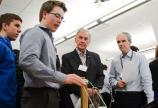Engineering safety is no snow job
- Suzanne Ahearne

If getting to the top of your favourite ski hill involves a tow rope this season, you might thank an engineer for the lift—and give a thought to how the profession works to ensure that a safe, smooth ride can be enjoyed by all.
The incidence of deropements of surface lifts in BC is low but when the cable does come off the pulley on a tow rope or T-bar, it can present safety concerns for snowboarders and skiers. But because the injuries caused by deropements are rarely serious, there’s also less incentive for facilities to invest in design improvements.
That gap—between bottom line and public interest—was put before 450 first-year engineering design students (Engr. 110 and 112), in collaboration with the BC Safety Authority (BCSA) this Fall. Their task: design and implement safer prototypes, including testing, braking and fail safe components.
The focus of the course was the central role of safety in engineering design as well as the importance of codes and standards.
The number one cause of deropements, students discovered, is rider behavior. Skiers and snowboarders, bored with the slow, straight lift up the hill, start using the T-bar or tow-rope to carve side to side. After a certain point, the lateral force will pull the cable right off the pulley and if not caught by the rope catcher, the cable can cause injury to riders.
BCSA engineers Jason Gill and Jeff Coleman spent more than 40 hours over the course of the term working with more than100 student groups to refine ideas and come up with solutions—some mechanical, some electrical and some sensor-based.
Professor Peter Wild said the course surprises a lot of first-year students who underestimate how important non-technical competencies are to engineering success.
Student Michael Richards said some of the most important lessons he learned had to do with these “soft skills” of engineering: design processes, critical thinking and communication skills with both the client and team members. Added to this, he said, was his team’s mixed first-hand experience with skiing; two were experienced skiers, one had never skied before and one had never even seen snow. BCSA mentors helped them navigate these slopes too.
After months of work, fifteen groups presented their projects to industry and academic judges and five were given awards. “The caliber of work was well beyond what I was expecting of students in their first semester at university,” said Coleman, BCSA’s leader of research and engineering. “We look forward to opportunities to provide real life learning experiences for students in the future.”
Photos
In this story
Keywords: BC Safety Authority, safety, ski, research
People: Jason Gill, Jeff Coleman, Michael Richards

